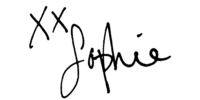
Good Morning!
If you follow me on Instagram – and you should! – you may have caught my insta story a couple weeks ago. I was at Fancy Tiger Crafts to teach a lingerie sewing class, and I was talking about my stitch guides!
Every class I teach, I make a little stitch guide for each of the sewing machines. They include the name of the sewing machine, an example of each of the stitches that we’ll be using on our project, and all of the individual machine settings – stitch, width, and length, so you can easily flip between perfect stitches without fussing and testing each one a thousand times!!

This saves so much time as lingerie newbies can jump right in to making their undies without going through the trials of finding out which stitches will work and look the best. It’s also a great reference because you can really find the sweet spot on your machine with the stitch length and width, and then always remember exactly how you had it!

THE STITCHES
So there are four stitches that we routinely use in our lingerie making. The first two are regular straight and basting stitches, and the second two are variations on a regular zig zag stitch.

STRAIGHT STITCH
A straight stitch is your basic, regular sewing stitch. This is the one you use for normal sewing on woven fabrics. On lingerie, you can sometimes use a straight stitch if you’re using non-stretch fabrics, but if your fabric stretches at all, a regular straight stitch will break when the fabric is stretched. This is why we use zig zag stitches! We use the straight stitch for connecting elastic pieces into circular bands, hook and eye tabs, and for reinforcing any portions of a garment that might have a lot of strain, or that we don’t want to stretch.
BASTING STITCH
A basting stitch is the regular straight stitch, except that the stitch length is increased to the maximum allowed by your sewing machine. This makes stitches long and very loose. Basting stitches are used as temporary seams in fitting garments. We use basting seams as a method for ensuring perfect seam allowances when we apply elastic to the edges of garments. You can tell that in the picture above, the first seam is the basting stitch, because its stitches are so much longer than the seam below it.

THREE STEP ZIG ZAG
The three step zig zag is our workhorse stitch – if you don’t have a serger or overlock machine (they’re the same thing) this is the best stitch I’ve found for sewing knits. Each individual zig and zag has three stitches to it, instead of one. This gives it a lot of strength, and can stretch way more without breaking than a normal zig zag stitch. It’s about 1/4″ wide, which is exactly our seam allowance on our lingerie! Line up the edge of the points near to the edge of the fabric (near, not on), and you’ll have perfect seams every time!

SHORT ZIG ZAG
The short zig zag is a regular zig zag stitch, with the stitch length decreased significantly – we like to keep it at 0.8 on our machines. This is a very tight, close stitch, and it’s very strong. We use this stitch for attaching rings, sliders, straps, and hook and eye tabs in some cases.
THE STITCH GUIDE
Download your own Lingerie Stitch Guide and spend some time playing with your sewing machine! You can record all your favourite stitches to refer back to whenever you want to whip out a few pairs of new undies! There are examples of what your stitch should look like, as well as a place for you to record what your particular seam looks like – just sew a little line between the two markers, and then write down the stitch, width, and length that you used! Perfect timing.
Happy Sewing!

